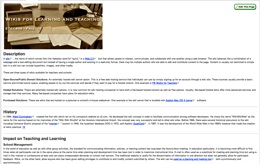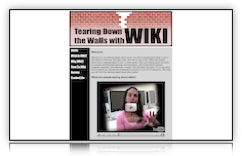

older projects



A review of the contemporary literature concerning the introduction and implementation of Interactive whiteboards
An informational site designed to assist educators who wish to utilize wikis in the content curricula or for professional planning and collaboration
The use of the Web 2.0 tools and particularly wikis in the classroom, has the potential to dramatically change the way in which learning and teaching takes place. Students have changed dramatically in the last few years. 21st century students are not well served by 19th and 20th century teaching styles. Most students in the modern high school can be considered as "digital natives.12" These students spend a great portion of their waking hours connected digitally. The use of the wiki in learning and teaching directly addresses the skill sets that will be necessary for collaboration and knowledge creation in the world in which our students will live and work.
Title: Wikis in K12
Course: ETEC 602 Teaching/Training Technologies
Course information: Fall 2010, Dr. Curtis Ho
Reflection and Description of technology and teaching strategies
This is an informational piece designed to provide K12 educators with an introduction to the background and uses in the educational environment of wikis.
This project incorporates aspects of the following three of the Association for Educational Communications and Technologies Standards
I-- Design
II- Development
V- Evaluation
Project conception
This informational module was conceived as a quick source of information for teachers who are interested in experimenting with Web 2.0 tools in their teaching practice as well as for administrators who seek an alternative to time-consuming face-to-face meetings. The use of wikis allows groups to asynchronously collaborate, share information and provide input.
Evaluation and comments
“This is an excellent posting. You even make the wiki page like a web page. This work must be take a long time, since I know that wiki space is not friendly at all for formatting a page. Thank you for sharing information on this page. I learn more from this page and resources you listed very helpful for helping people who want to do a research about wiki.” -Graduate Assistant
“The feature I liked most was the information about "Benefits of Using Wikis in the school setting." The author provided valuable information in regards to ways to incorporate wikis in education. I really enjoyed reading through each heading.” -Course Member
Title: Expanding the Walls of the K12 Classroom with Web2 Tools
Course: ETEC 649 Developing Online Courseware
Course information: Spring 2010, Dr. Curtis Ho
Reflection and Description of technology and teaching strategies
This is an online course for teachers in the public high school that utilizes synchronous and asynchronus learning strategies. It also provides for the development of a collegial relationship among the participants that supports the diffusion and institutionalization of the course material.
Most teachers in the public high school setting are aware that their students are very different from previous generations in the way in which they locate, interact with, and communicate information.
Their interaction with peers is also qualitatively and quantitatively different than it was in the past. This generational difference between teacher and student has been described elsewhere as the difference between the “Digital Native” and the “Digital Immigrant”.
Many teachers have made steps toward closing this generational digital divide by utilizing the internet, smartphones, and social networking media in their personal lives but are often reluctant to bring these tools into the classroom or to use these same tools to break the bonds of classroom walls and bell schedules.
This quarter-long course seeks to provide a cohort of high school teachers with the expertise, exposure, experience, and collegial support necessary to allow them to begin to infuse content-area curricula with contemporary digital tools for learning, teaching and collaboration.
This project incorporates aspects of all five of the Association for Educational Communications and Technologies Standards
I-- Design
II- Development
III- Utilization
IV- Management
V- Evaluation
Project conception
This course was conceived in response to the recognition that many if not most teachers in the public high school are uncomfortable with the idea of utilizing the tools of contemporary digital technologies and communication modalities in the teaching of their content curricula.
This course seeks both to present and to model the use of these tools as the teachers incorporate them into their professional practice over the course of the quarter.
Evaluation and comments
Unfortunately, commentary from students and the instructor for the course were made to a Ning social media site and are not at this time available. I am working to try to recover this information.
Tearing Down the Walls with Wiki
This Learning Object was presented on April 21, 2010 at the 15th TCC Worldwide Online Conference
Title: Tearing Down the Walls with Wiki - A Learning Object
Course: ETEC 649 Developing Online Courseware
Course information: Spring 2010, Dr. Curtis Ho
Reflection and Description of technology and teaching strategies
This instructional module or Learning Object was developed as a means to introduce K12 teachers and administrators to the use of wikis for learning, teaching, management, and collaboration.
It was produced as a group effort of a team consisting of myself, Ms Miki Kamimura, and Ms Macy Huynh and was presented during the 15th TCC Worldwide online Conference in April 2010.
This project incorporates aspects of following three of the Association for Educational Communications and Technologies Standards
I-- Design
II- Development
III- Utilization
Project conception
This learning object was conceived to provide education professionals with a quick introduction to the use of wikis in teaching, learning, management and collaboration. It also serves as a source of information for further investigation and to demonstrate how educational professionals can quickly and at low or no cost set up a wiki for their own use.
Evaluation and comments
Unfortunately, commentary from students and the instructor for the course were made to a Ning social media site and are not at this time available. I am working to try to recover this information.
Association for Educational Communications and Technology
US Department of Education, Office of Educational Technology
Project Exemplars - produced in conjunction with courses taken in the ETEC Department


Instructional Whiteboards in Teaching and Learning: A literature Review
a look at the current literature about IWB implementation
Course: ETEC 611 Developing Online Courseware
Course information: Spring 2011, Dr. Grace Lin
Description
Abstract
Most of the early studies of IWB adoption and use focused primarily on one of the two major forces in the classroom; teachers and students. Teacher studies dealt mainly with adoption, use, and changes in pedagogy occurring following the introduction of the IWB to the classroom. Student studies tend to look at attitude, engagement, and achievement.
Teacher and student studies seem to agree that simply having the IWB technology in the classroom does not guarantee teacher success or student achievement. There are many other factors involved.
An emerging area of investigation involves the study of classrooms as dynamic systems of interaction and a complex cultural environment. The introduction of tools such as IWBs can have a significant and profound impact on this environment and bring about a number of inter- connected events that significantly influence the ways in which teachers teach and students learn
Keywords: IWBs, ICT, systems, pedagogy, attitudes,



cellodad 2013



